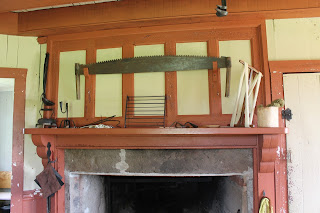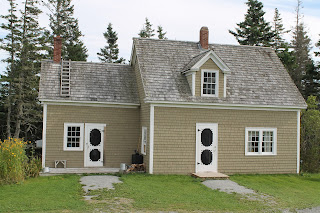After
leaving the Cabot Trail, I had requested that we take a detour off of the main
road for a day trip to the Highland Village in Iona. Iona looks out over
another section of the Bras D’or Lake. We had to pay $7 to take a cable ferry
to get there, which luckily for us we had otherwise my field trip would have
ended before it had begun. The Highland Village is a self-guided walking tour
through 200 years of Gaelic history in Nova Scotia. At each stop are costumed
employees in character for that era. They were all very knowledgeable and
worked hard to make it a memorable experience. Please join us for a long
picture post today, with descriptions from their pamphlet, as we take you back
in time to the late 1700’s. Follow the Scottish immigrants to Nova Scotia and
walk alongside them through 200 years of history.
Gaelic Scotland 1770's-1830's
An Taigh Dubh
The Black house
Living in the Highlands and Islands of Scotland, we are rich in Gaelic tradition, story, song and music. We are a hardy and enduring people, close in kinship ties. We gather fireside to discuss rising rents, the promise of land grants and a new life across the ocean
The forests of Nova Scotia 1770's-1850's
An Taigh-logaichean
The log house ( obviously under construction)
Having crossed the ocean with little else but our language and culture, we are now settled on land we can call our own. We are well suited to a challenging life in the great Acadian Forest. Our hearth remains a comfortable place, where we gather to tell stories, sing songs and sometimes make music, or pray at the end of a long day's work.
Little make shift house
Taigh an t-Simileir
Centre Chimney House
Establishing fields and livestock will secure our land grant. Although living conditions have changed, our language and kinships remain the same. After weary days clearing fields from the forest, we visit by the kitchen fire to enjoy Gaelic stories, song and music.
An Sabhal
The Barn
The barn safeguards our equity earned by years of toil. Throughout the changing seasons, our barns and fields resonate with work songs. Gaelic music and song remain inseparable from every aspect of our lives.
Building new communities 1850's-1880's
An Eaglais
The church
In these early days of new communities, we are often without clergy. As churches are built, we walk or travel in sleighs, wagons and boats to attend Mass or Sunday services.
Taigh na Trannsa
Centre Hallway House
Many of our families have been in Nova Scotia for nearly 100 years and our land holdings are becoming secure. The open hearth is slowly being replaces with cast iron stoves, but the kitchen remains our main place to visit. Our communities are growing as our children and grand-children build new homes, though some have moved on to opportunities in Upper Canada, or the Boston states.
Gaelic Nove Scotia 1880's-1920's
An Taigh-sgoil
The School House
Teachers are instructed to teach in English only. Our children are often punished for speaking Gaelic in school. We are told that their futures lie in speaking English. On special evenings, and at times of celebration, we move desks aside to dance to music, or sing at the milling table.
An Taigh-marsantachd
The General Store
Merchants have opened stores to serve our needs for staples and merchandise. Credit is commonly extended. Sometimes, we settle bills by bartering butter, eggs and knitted items. Our store houses the local post office, where we often exchange news and songs with neighbours.
A' Cheardach
The Forge
The forge is our hardware store and repair shop. Since ancient times, the smith has been an esteemed trades person in Gaelic society. Our men gather here for Gaelic conversation, as ironwork is done and horses are shod.
Am Muileann-cardaidh
The Carding Mill
Wool, and its preparation, for spinning are very important to our rural life. With the carding mill, we no longer have to card large amounts of wool by hand. Many Gaels from nearby districts bring fleeces here to be picked and carded. For centuries, spun wool has been used on our looms to weave the great cloth used in making blankets and clothing.
Taigh Tus na Ficheadamh Linn
Turn of the Century House
Five generations on, stories are still told about the first Gaels arriving in Nova Scotia. We have modern conveniences, but the cows still have to be milked and the hay made. We speak Gaelic to each other and the older generations, but not much to the children. Although well established, rural communities are often unable to sustain our large families. Many have left for work, or adventure, and some are off to the Great War.
















































No comments:
Post a Comment